This is an AI Free Zone! Text created by ChatGPT and other Large Language Models is spreading rapidly across the Internet. It's well-written, artificial, frequently inaccurate. If you find a mistake on Spaceweather.com, rest assured it was made by a real human being. | | |
CME IMPACT: A coronal mass ejection (CME) hit Earth's magnetic field on July 25th at 2235 UT. So far the impact has not caused a geomagnetic storm, although G1-storms are possible in the hours ahead as Earth passes through the CME's turbulent wake. It is unclear if this is the early arrival of a CME originally expected on July 27th or a completely different CME which was previously overlooked. Solar flare alerts: SMS Text
A COMET SHAPED LIKE THE MILLENNIUM FALCON: Until a few days ago, Comet 12P/Pons-Brooks looked like a perfectly ordinary comet. Then, something on its surface exploded. Now it resembles "the fastest hunk of junk in the galaxy"--the Millennium Falcon:
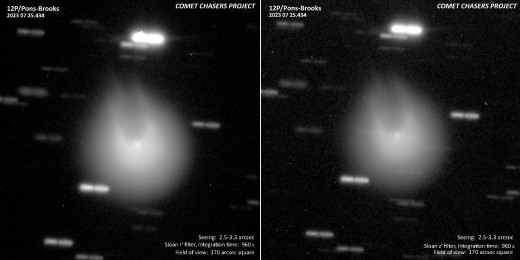
These images are hot off the press (July 25.434) from the Comet Chasers, a team of researchers led by Helen Usher of Cardiff/The Open Universities. They are using telescopes at the Las Cumbres Observatory network to monitor this comet's unusual eruption.
The action began on July 20th when the comet abruptly brightnened 100-fold. Astronomers watched as double plumes of debris streamed out of the comet's core, sweeping back to form the Falcon shape. It is now shining with about the same brightness as an 11th magnitude star, making it an easy target for mid-sized backyard telescopes.
Comet 12P/Pons-Brooks is famous for exploding. Discovered in 1812 by Pons and discovered again in 1883 by Brooks, the bursty comet visits the inner solar system every 71 years. Since the 19th century at least seven significant outbursts have been observed.
At the Astronomical Station Vidojevica in Serbia, astronomers Igor Smolić and Marco Grazdanovic took a closer look using the station's big 1.4 meter telescope:
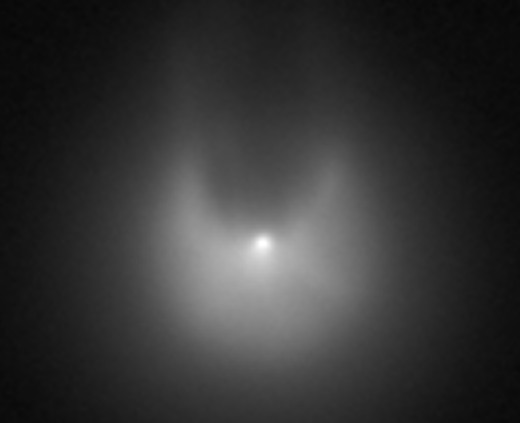
"This is a 60x30s exposure," says Smolić. "[It reveals the origin of the 'horns' curving out of the comet's compact core]."
Richard Miles of the British Astronomical Association thinks 12P may be one of 10 to 20 known comets with active ice volcanoes. The "magma" is a cold mixture of liquid hydrocarbons and dissolved gasses, all trapped beneath a surface which has the consistency of wax. These bottled-up volatiles love to explode when sunlight opens a fissure.
The best may be yet to come. The comet is currently beyond the orbit of Mars, but falling toward the sun for a close encounter in April 2024. At that time it is expected to become a naked-eye object at 4th or 5th magnitude.The timing is significant because 12P will reach maximum brightness only a few days before the total solar eclipse on April 8, 2024. Sky watchers in the path of totality could look up and see an outburst for themselves.
Amateur astronomers are encouraged to monitor developments. Comet 12P is currently crossing the head of Draco not far from the north celestial pole. Check out those horns! And submit your photos here.
more images: from Thomas Wildoner of Weatherly, PA; from David Strange of Salcombe Regis, East Devon, UK
Realtime Space Weather Photo Gallery
Free: Spaceweather.com Newsletter
STERLING SILVER STARCAT: Are you looking for a far-out gift? Introducing the Sterling SIlver StarCat Pendant. On July 14th, it hitched a ride to the stratosphere onboard an Earth to Sky Calculus cosmic ray research balloon:
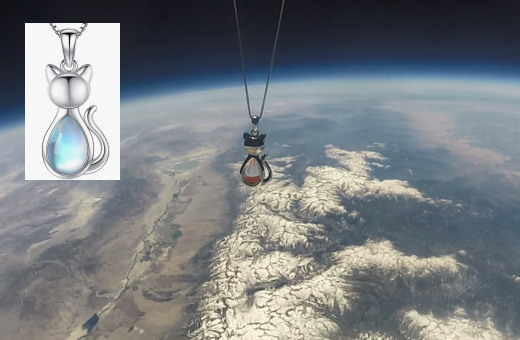
You can have it for $159.95. The silver feline form is wrapped around a genuine moonstone with a matching 18 inch Italian sterling silver chain. It is 100% hypoallergenic.
The students of Earth to Sky are selling space pendants to support their cosmic ray ballooning program. Each one comes with a greeting card showing the pendant in flight and telling the story of its trip to the stratosphere and back again.
Far Out Gifts: Earth to Sky Store
All sales support hands-on STEM education
Realtime Noctilucent Cloud Photo Gallery
Free: Spaceweather.com Newsletter
Realtime Aurora Photo Gallery
Free: Spaceweather.com Newsletter
Every night, a network of
NASA all-sky cameras scans the skies above the United States for meteoritic fireballs. Automated software maintained by NASA's Meteoroid Environment Office calculates their orbits, velocity, penetration depth in Earth's atmosphere and many other characteristics. Daily results are presented here on Spaceweather.com.
On Jul 24, 2023, the network reported 21 fireballs.
(15 sporadics, 5 alpha Capricornids, 1 southern Delta Aquariid)
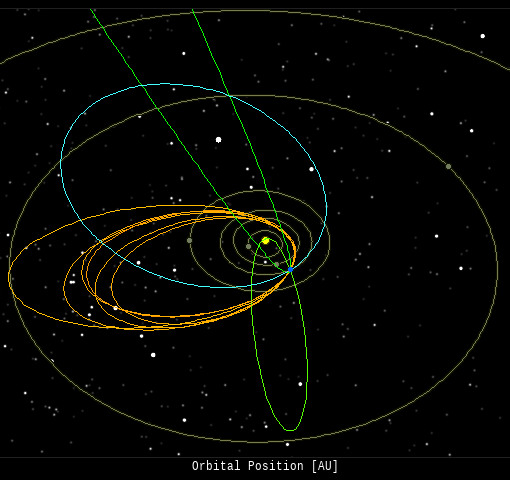
In this diagram of the inner solar system, all of the fireball orbits intersect at a single point--Earth. The orbits are color-coded by velocity, from slow (red) to fast (blue). [Larger image] [movies]
Potentially Hazardous Asteroids (
PHAs) are space rocks larger than approximately 100m that can come closer to Earth than 0.05 AU. None of the known PHAs is on a collision course with our planet, although astronomers are finding
new ones all the time.
On July 25, 2023 there were 2335 potentially hazardous asteroids.
 |
Recent & Upcoming Earth-asteroid encounters: | Asteroid | Date(UT) | Miss Distance | Velocity (km/s) | Diameter (m) |
| 2022 GX2 | 2023-Jul-20 | 11.9 LD | 9.4 | 5 |
| 2023 NL | 2023-Jul-20 | 19.1 LD | 5.5 | 43 |
| 2020 OM | 2023-Jul-20 | 8.5 LD | 9.5 | 15 |
| 2023 OS | 2023-Jul-21 | 5.1 LD | 10.8 | 48 |
| 2023 OV1 | 2023-Jul-21 | 1.4 LD | 13.4 | 29 |
| 2023 NM1 | 2023-Jul-21 | 13.3 LD | 8.9 | 35 |
| 2023 MX5 | 2023-Jul-21 | 11.9 LD | 11.8 | 61 |
| 2023 NR1 | 2023-Jul-22 | 2.9 LD | 15.2 | 78 |
| 2023 MM3 | 2023-Jul-22 | 19.1 LD | 6.4 | 46 |
| 2023 OU | 2023-Jul-22 | 1.8 LD | 6.1 | 22 |
| 2015 MA54 | 2023-Jul-24 | 16.6 LD | 9.2 | 31 |
| 2023 OW | 2023-Jul-25 | 19.8 LD | 8.7 | 39 |
| 2023 OR1 | 2023-Jul-27 | 3.1 LD | 11.4 | 18 |
| 2018 BG5 | 2023-Jul-27 | 10.8 LD | 8.4 | 54 |
| 2020 PP1 | 2023-Jul-29 | 17 LD | 4.1 | 17 |
| 2021 BD3 | 2023-Jul-30 | 14 LD | 8.5 | 25 |
| 2016 AW65 | 2023-Jul-31 | 16.7 LD | 5.7 | 47 |
| 2023 OF1 | 2023-Aug-02 | 17.8 LD | 10.8 | 39 |
| 2020 PN1 | 2023-Aug-03 | 10.8 LD | 4.8 | 29 |
| 620082 | 2023-Aug-04 | 14 LD | 20.6 | 377 |
| 2023 OQ | 2023-Aug-06 | 10 LD | 21.4 | 145 |
| 2004 KG1 | 2023-Aug-06 | 19.9 LD | 9.1 | 56 |
| 2022 BS2 | 2023-Aug-11 | 17.3 LD | 8.2 | 30 |
| 2022 CP1 | 2023-Aug-17 | 13.8 LD | 9.8 | 12 |
| 2011 QJ21 | 2023-Aug-19 | 13 LD | 15.1 | 45 |
| 6037 | 2023-Aug-23 | 15.9 LD | 14.3 | 571 |
| 2012 PZ17 | 2023-Aug-30 | 16.8 LD | 3.6 | 16 |
| 2017 BY32 | 2023-Sep-02 | 16.4 LD | 3.5 | 19 |
| 2021 JA5 | 2023-Sep-06 | 13.3 LD | 10.9 | 19 |
| 2020 GE | 2023-Sep-08 | 14.9 LD | 1.4 | 8 |
| 2020 RT2 | 2023-Sep-12 | 11 LD | 10 | 8 |
| 2016 LY48 | 2023-Sep-16 | 5 LD | 10.8 | 99 |
| 2010 TE | 2023-Sep-16 | 6.8 LD | 6 | 22 |
| 523598 | 2023-Sep-20 | 19.8 LD | 25 | 239 |
Notes: LD means "Lunar Distance." 1 LD = 384,401 km, the distance between Earth and the Moon. 1 LD also equals 0.00256 AU. | | Cosmic Rays in the Atmosphere |
SPACE WEATHER BALLOON DATA: Almost once a week, Spaceweather.com and the students of Earth to Sky Calculus fly space weather balloons to the stratosphere over California. These balloons are equipped with sensors that detect secondary cosmic rays, a form of radiation from space that can penetrate all the way down to Earth's surface. Our monitoring program has been underway without interruption for 7 years, resulting in a unique dataset of in situ atmospheric measurements.
Latest results (July 2022): Atmospheric radiation is decreasing in 2022. Our latest measurements in July 2022 registered a 6-year low:
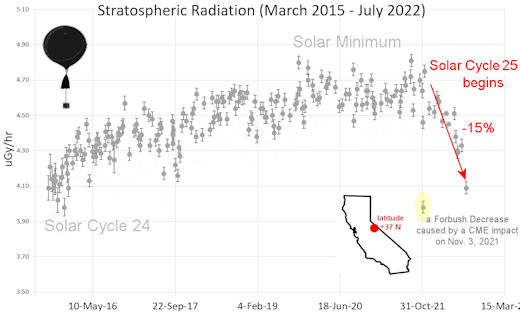
What's going on? Ironically, the radiation drop is caused by increasing solar activity. Solar Cycle 25 has roared to life faster than forecasters expected. The sun's strengthening and increasingly tangled magnetic field repels cosmic rays from deep space. In addition, solar coronal mass ejections (CMEs) sweep aside cosmic rays, causing sharp reductions called "Forbush Decreases." The two effects blend together to bring daily radiation levels down.
.Who cares? Cosmic rays are a surprisingly "down to Earth" form of space weather. They can alter the chemistry of the atmosphere, trigger lightning, and penetrate commercial airplanes. According to a study from the Harvard T.H. Chan school of public health, crews of aircraft have higher rates of cancer than the general population. The researchers listed cosmic rays, irregular sleep habits, and chemical contaminants as leading risk factors. A number of controversial studies (#1, #2, #3, #4) go even further, linking cosmic rays with cardiac arrhythmias and sudden cardiac death.
Technical notes: The radiation sensors onboard our helium balloons detect X-rays and gamma-rays in the energy range 10 keV to 20 MeV. These energies span the range of medical X-ray machines and airport security scanners.
Data points in the graph labeled "Stratospheric Radiation" correspond to the peak of the Regener-Pfotzer maximum, which lies about 67,000 feet above central California. When cosmic rays crash into Earth's atmosphere, they produce a spray of secondary particles that is most intense at the entrance to the stratosphere. Physicists Eric Regener and Georg Pfotzer discovered the maximum using balloons in the 1930s and it is what we are measuring today.
| | The official U.S. government space weather bureau |
| | The first place to look for information about sundogs, pillars, rainbows and related phenomena. |
| | Researchers call it a "Hubble for the sun." SDO is the most advanced solar observatory ever. |
| | 3D views of the sun from NASA's Solar and Terrestrial Relations Observatory |
| | Realtime and archival images of the Sun from SOHO. |
| | information about sunspots based on the latest NOAA/USAF Active Region Summary |
| | current counts of failed and deployed Starlink satellites from Jonathan's Space Page |
| | Authoritative predictions of space junk and satellite re-entries |
| | from the NOAA Space Environment Center |
| | fun to read, but should be taken with a grain of salt! Forecasts looking ahead more than a few days are often wrong. |
| | from the NOAA Space Environment Center |
| | the underlying science of space weather |
 | Getting YouTube comments is essential if you want to beat the algorithm! That’s why you need to buy YouTube comments from RealSocialz.com because they offer real USA comments you can customize. |
 | When looking for casinos to play online when the weather is bad, you can try casino online trucchi for Italian games. If you are not from Finland you can try the Swedish page Svenska casino online to find suitable games, check out svenskacasinoonline.net. Always check your local laws before playing with real money. |
 | BestCSGOGambling is the best site for everything related to CSGO gambling on the web |
| | These links help Spaceweather.com stay online. Thank you to our supporters! |
| | | | | | |

